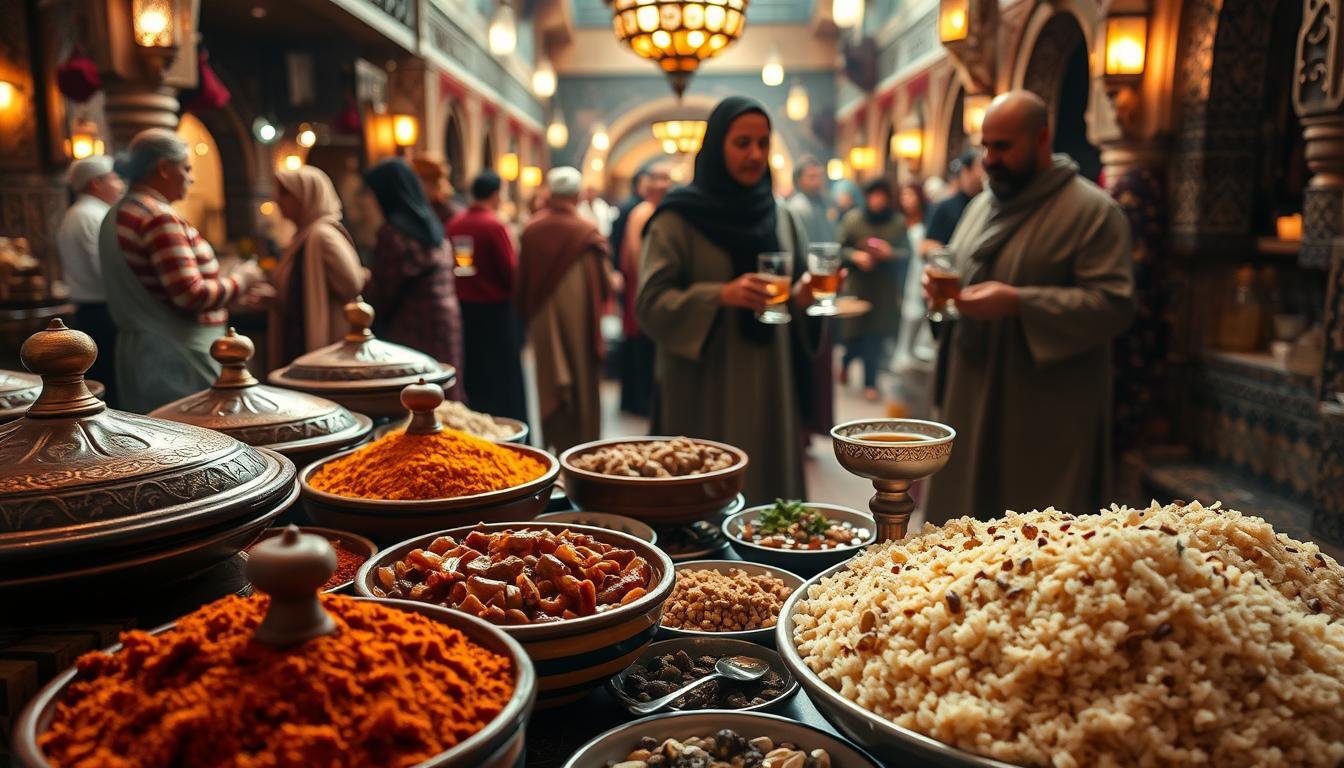Are you ready to explore Morocco’s amazing food? The smells of spices and the taste of traditional dishes will make you want more. As you plan your trip, you might wonder what dishes to try.
Moroccan food is a mix of flavors, thanks to the country’s location. Expect to enjoy dishes that are sweet, savory, and spicy.
From rich stews to light pastries, Moroccan food has something for everyone. When you visit local markets and restaurants, make sure to try the signature dishes that show off the country’s food heritage.
Key Takeaways
- Discover the rich flavors of Moroccan cuisine
- Explore the variety of traditional dishes to try
- Learn about the cultural influences on Moroccan cooking
- Find out what to expect from your culinary journey
- Get ready to indulge in sweet, savory, and spicy flavors
The Rich Culinary Heritage of Morocco
Exploring Morocco’s flavors reveals a unique culinary identity. It’s shaped by centuries of cultural exchange. Moroccan cuisine shows the country’s strategic spot at the crossroads of Africa, Europe, and the Middle East.
The Blend of Berber, Arab, and Mediterranean Influences
Morocco’s culinary scene is a mix of Berber, Arab, and Mediterranean flavors. Berber traditions use local ingredients like olives, almonds, and citrus fruits. Arab spices and cooking methods are now key in Moroccan dishes. Mediterranean trade has also added seafood and preserved lemons.
- Berber contributions: local ingredients and traditional cooking methods
- Arab influences: spices and sophisticated cooking techniques
- Mediterranean impact: introduction of seafood and preserved ingredients
The Importance of Spices in Moroccan Cooking
Spices are vital in Moroccan cooking, adding depth to dishes. Ras el hanout, a mix of over 30 spices, is a key flavor in tagines, couscous, and more. Spices like cumin, coriander, cinnamon, and ginger also add unique flavors.
Understanding Morocco’s culinary heritage shows the blend of Berber, Arab, and Mediterranean influences. It highlights the role of spices in Moroccan cuisine’s distinctive flavors.
Essential Spices and Ingredients in Moroccan Cuisine
Exploring Moroccan cuisine opens a world of flavors. It’s all about a mix of spices and key ingredients. Morocco’s rich culinary history shines through in its traditional recipes. These often include a blend of spices, preserved foods, and fresh produce.
The Magic of Ras el Hanout and Other Spice Blends
Ras el Hanout, or « head of the shop, » is a key Moroccan spice mix. It can change a lot depending on who makes it. This blend has over 30 ingredients like cinnamon, cumin, and cardamom. Ras el Hanout brings warmth and depth to many Moroccan dishes.
Preserved Lemons, Olives, and Other Staple Ingredients
Preserved lemons and olives are big in Moroccan cooking. They add a salty, tangy taste to dishes. Lemons are pickled, and olives are cured in salt or oil. They’re used in tagines and salads, making Moroccan recipes even more flavorful.
| Ingredient | Use in Moroccan Cuisine |
|---|---|
| Ras el Hanout | Spice blend used in tagines, couscous, and other dishes |
| Preserved Lemons | Used in tagines, salads, and as a condiment |
| Olives | Cured and used in various dishes, including tagines and salads |
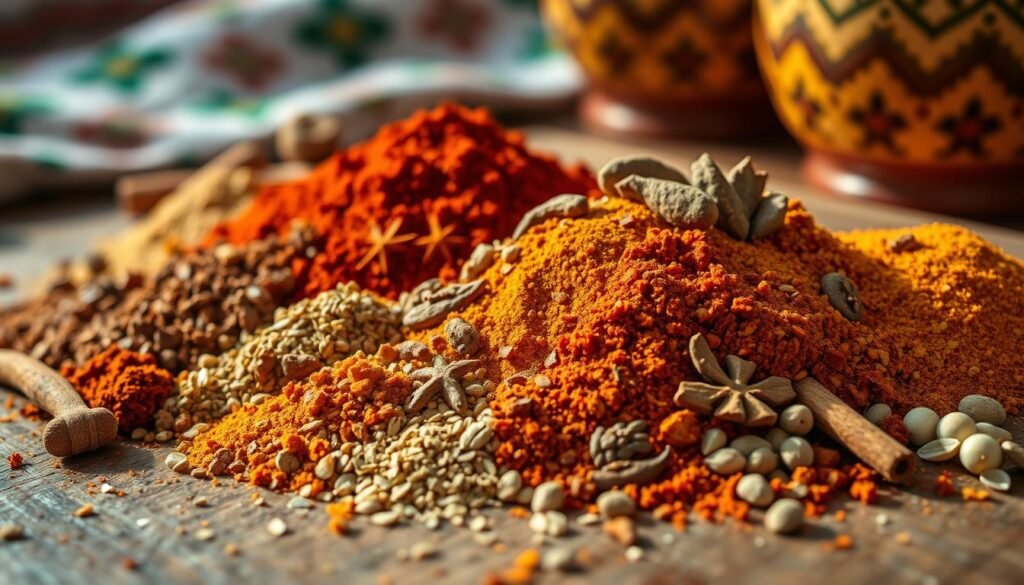
Top Dishes in Morocco You Can’t Miss
Moroccan cuisine is a mix of flavors and textures. Some dishes are must-tries. Exploring the Best Moroccan foods shows the country’s rich culinary heritage.
Tagine: The Iconic Slow-Cooked Stew
Tagine is a famous Moroccan dish. It’s a slow-cooked stew cooked in an earthenware pot. The dish has tender meat, like lamb or chicken, in a rich sauce with spices, dried fruits, and nuts.
The slow cooking process blends the flavors. This creates a memorable taste experience.
Couscous: The National Dish of Morocco
Couscous is more than a dish; it’s a symbol of hospitality. It’s made from semolina flour and steamed. It’s served with vegetables and meats.
This dish is versatile. It can be enjoyed alone or as part of a meal. It’s one of the Best Moroccan foods to try.
Harira: The Hearty Moroccan Soup
Harira is a comforting soup. It’s a common start to meals during Ramadan. It’s made with tomatoes, lentils, chickpeas, and spices.
Harira is filling and flavorful. It’s often served as a starter or light meal. It shows the hearty side of Moroccan cuisine and is a Famous Moroccan meal.
Rfissa: Chicken with Lentils and Msemen Bread
Rfissa is a traditional Moroccan dish. It has chicken, lentils, and msemen (flatbread). The combination of tender chicken, flavorful lentils, and soft msemen bread is satisfying and delicious.
Rfissa is served on special occasions. It highlights its importance in Moroccan culinary traditions.
These dishes are some of the Best Moroccan foods and Famous Moroccan meals to try in Morocco. Each dish offers a unique taste of the country’s rich culinary heritage. They are must-try experiences for food enthusiasts.
Delicious Moroccan Appetizers and Salads
Morocco’s appetizers and salads show off the country’s rich food history. They mix old flavors with new ideas. You’ll see dishes that taste great and look good too.
Zaalouk and Other Eggplant-Based Starters
Zaalouk is a favorite Moroccan starter. It’s made with eggplant, tomatoes, and spices. It’s great as a side or on bread.
Other eggplant dishes include grilled eggplant with chermoula. This is a sauce of herbs and garlic. And there are eggplant fritters, crispy bites filled with eggplant and spices.
Moroccan Salads: A Rainbow of Flavors
Moroccan salads are full of colors and tastes. They mix fresh veggies, fruits, and nuts. You’ll find carrot salad with cumin and coriander, beet salad with orange and cinnamon, and tomato and olive salad.
These salads are tasty and refreshing. They’re a nice break from the richer meat dishes.
| Dish | Main Ingredients | Flavor Profile |
|---|---|---|
| Zaalouk | Eggplant, Tomatoes, Spices | Rich, savory, slightly spicy |
| Grilled Eggplant with Chermoula | Eggplant, Chermoula sauce | Smoky, herby, garlicky |
| Eggplant Fritters | Eggplant, Spices, Herbs | Crispy, savory, slightly spicy |
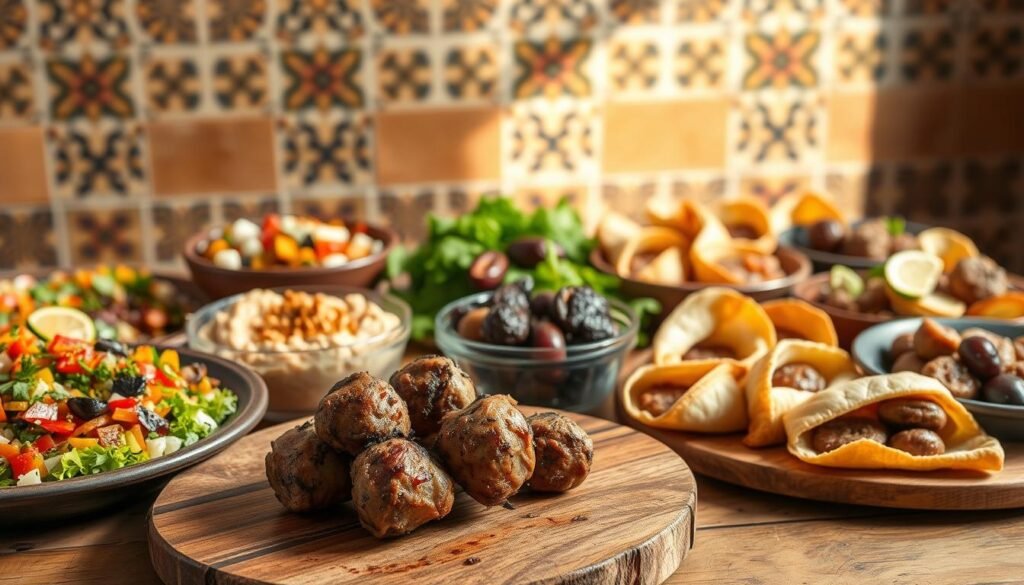
Savory Meat Dishes That Define Moroccan Cuisine
Exploring Moroccan cuisine reveals a world of savory meat dishes. These dishes are flavorful and hold cultural significance. They showcase the country’s rich culinary heritage and diverse cultural influences.
Mrouzia: Sweet and Savory Lamb with Honey and Almonds
Mrouzia is a traditional Moroccan dish. It’s made with lamb, honey, and almonds, often served at special times. The honey’s sweetness and the almonds’ crunch pair well with the tender lamb, making it unforgettable.
Pastilla: The Sweet and Savory Pie
Pastilla is a savory pie with layers of flaky pastry and a rich filling. It’s filled with meat, onions, and spices. It’s served as an appetizer or main course, known for its complex flavors and textures.
Mechoui: Slow-Roasted Lamb for Special Occasions
Mechoui is slow-roasted lamb, perfect for special occasions. The lamb is marinated in spices and roasted to perfection. This results in tender, flavorful meat that impresses everyone.
| Dish | Main Ingredients | Occasion |
|---|---|---|
| Mrouzia | Lamb, Honey, Almonds | Special Occasions |
| Pastilla | Meat, Onions, Spices, Pastry | Appetizer or Main Course |
| Mechoui | Lamb, Spices | Celebrations |
These savory meat dishes are key to Moroccan cuisine. They offer a peek into the country’s rich culinary traditions and cultural heritage. Enjoying mrouzia, pastilla, or mechoui is a unique and delicious experience.
Seafood Specialties from Morocco’s Coastal Regions
Morocco’s long coastline is a treasure trove of seafood delights. The freshness of the catch, mixed with traditional marinades and cooking, makes Moroccan seafood a must-try. It’s a treat for your taste buds.
The coastal towns of Morocco, like Essaouira and Tangier, are known for their seafood. Here, you can find a variety of fish and seafood. They are prepared in ways that show off the region’s rich culinary heritage.
Chermoula-Marinated Fish Dishes
Chermoula-marinated fish is a standout in Morocco. Chermoula, a mix of herbs and spices, marinates fresh fish. Then, it’s grilled to perfection. This dish is flavorful and simple, showing the elegance of Moroccan cuisine.
Chermoula includes parsley, cilantro, garlic, and lemon juice. These ingredients make a marinade that brings out the fish’s natural flavors without overpowering them.
Seafood Tagines from Essaouira and Other Coastal Towns
Seafood tagines are a specialty of Morocco’s coast. These slow-cooked stews use a variety of seafood. They are cooked in clay pots with conical lids. This creates a rich, flavorful broth filled with spice and herb aromas.
| Seafood Dish | Main Ingredients | Cooking Method |
|---|---|---|
| Chermoula-Marinated Fish | Fresh fish, chermoula, lemon | Grilling |
| Seafood Tagine | Assorted seafood, spices, tomatoes | Slow-cooking |
When you try these seafood specialties, remember the freshness and traditional cooking. These are what make Moroccan seafood stand out. Whether in Essaouira or another coastal town, don’t miss out on these dishes. They are the best of Morocco’s seafood.
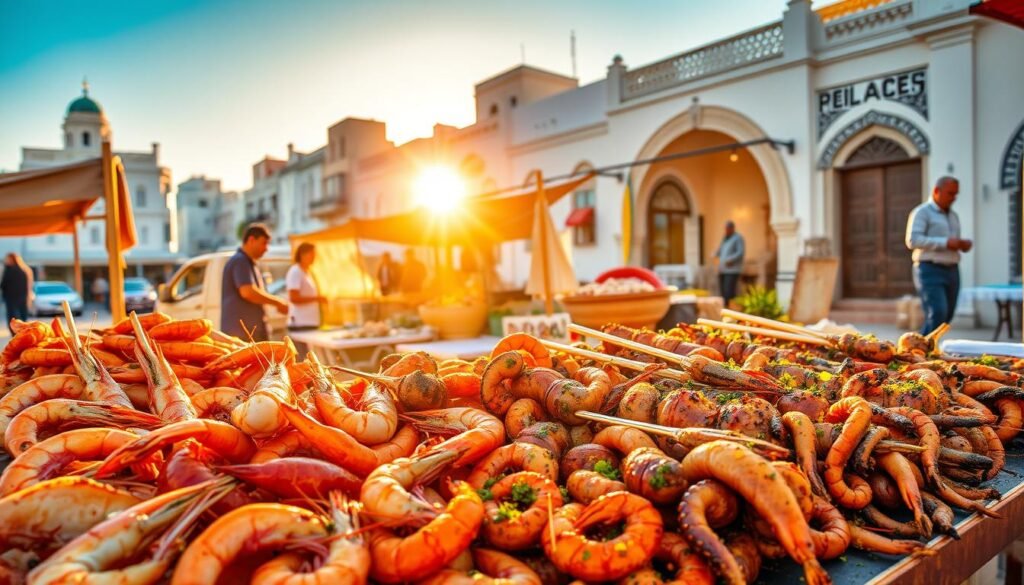
Street Food Adventures in Moroccan Markets
As you explore Morocco’s lively markets, the smells and tastes of street food will amaze you. The air buzzes with the scent of sizzling food and the voices of vendors. They call out their daily specials.
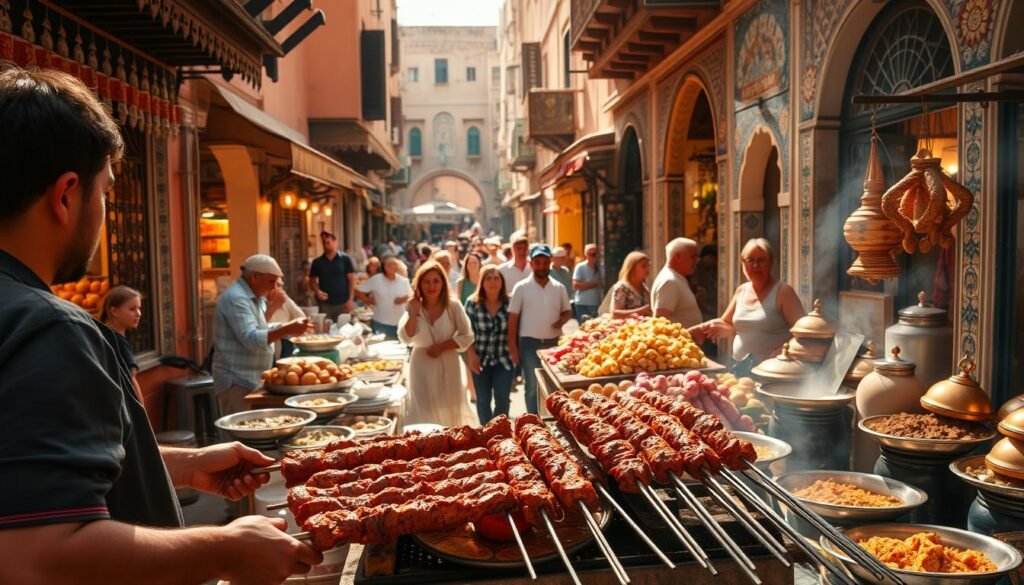
Moroccan street food is a journey of flavors and textures. You’ll find everything from tasty sandwiches to sweet pastries.
Moroccan Sandwiches: From Merguez to Brochettes
The sandwich is a big hit in Moroccan street food. Merguez, a spicy lamb sausage, is a favorite, served in a crispy baguette. Brochettes, or skewers of marinated meat, are also loved. They’re grilled to perfection over an open flame.
Sfenj and Msemen: Moroccan Breads and Pancakes
Don’t miss trying sfenj, a deep-fried treat like a doughnut, with coffee or tea. Msemen, a thin, folded pancake, can be savory or sweet. It’s filled with onions, meat, or honey.
Snail Soup and Other Adventurous Street Eats
For the bold, Moroccan markets offer unique foods like snail soup. It’s a hearty, comforting dish. You might also find fried insects or unusual meats, showing the variety of Moroccan cuisine.
Exploring Moroccan street food is an adventure. It leaves you with memories and a new appreciation for the country’s food traditions.
Regional Variations in Moroccan Cuisine
From the Mediterranean coast to the Sahara Desert, Moroccan flavors vary greatly. Each region in Morocco has its own special dishes. These are shaped by local ingredients, cultural influences, and history.
Northern Influences: The Mediterranean Coast
The northern parts of Morocco are known for their fresh seafood and Mediterranean tastes. Grilled fish and seafood tagines are favorites here. They often include the tang of preserved lemons and the depth of olives.
The area’s close ties to Spain and Europe also add to its unique flavors. This mix of Mediterranean habits makes the region stand out in Moroccan cuisine.
| Region | Key Ingredients | Popular Dishes |
|---|---|---|
| Northern Morocco | Fresh seafood, preserved lemons, olives | Grilled fish, seafood tagines |
| Central Morocco | Meat, almonds, spices | Mrouzia, pastilla |
| Southern Morocco | Dates, Berber spices, desert herbs | Tagines with dates, Berber couscous |
Central Morocco: The Royal Cuisine of Fez and Meknes
Central Morocco, especially Fez and Meknes, is famous for its royal cuisine. The dishes here are elaborate, showing the history of these cities as former capitals. Mrouzia, a lamb dish, and pastilla, a pie with meat and spices, are highlights of this area’s cuisine.
Southern Specialties: Berber Traditions and Desert Flavors
The south of Morocco is rich in Berber heritage. Its cuisine mirrors the desert’s beauty and challenges. Tagines with dates and couscous with Berber spices are common. They use local ingredients like dates and desert herbs, giving the region’s dishes a unique taste.
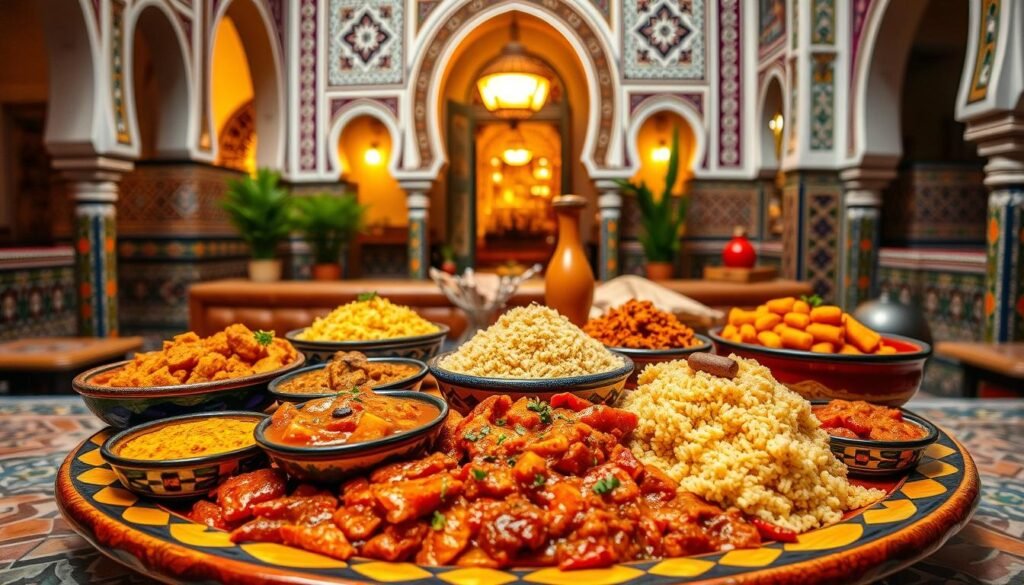
Sweet Treats and Beverages of Morocco
Exploring Morocco’s cuisine reveals a world of sweet delights and refreshing drinks. Moroccan food isn’t just savory; it also includes sweet pastries, teas, and juices. These are key parts of the country’s food culture.
Moroccan Pastries: Gazelle Horns and Chebakia
Moroccan pastries are famous for their designs and tastes. You must try Gazelle Horns (Kahwaat) and Chebakia. Gazelle Horns are crescent cookies with almond paste and orange blossom water. Chebakia are fried cookies in honey with sesame seeds.
These treats are enjoyed on special days. They show Morocco’s deep baking traditions.
The Art of Moroccan Mint Tea
Moroccan Mint Tea is more than a drink; it’s a sign of welcome and friendship. Making this tea is an art. It uses green tea, fresh mint, and sugar.
The tea is served in fancy teapots and small glasses. Making it is a group effort. To make real Moroccan Mint Tea, use top-notch green tea and fresh mint. Serve it with lots of sugar.
Fresh Fruit Juices and Other Refreshing Drinks
Morocco’s hot weather makes cool drinks essential. Orange and pomegranate juices are favorites. Avocado Juice, made with avocados, milk, and sugar, is also popular.
Salak Taranga, a citrus drink, is unique. These drinks not only cool you down but also show Morocco’s lively culture.
In conclusion, Morocco’s sweets and drinks add a lot to its cuisine. They offer a variety of tastes and traditions. Enjoying these treats, teas, and juices lets you experience Moroccan hospitality and culture fully.
Conclusion: Bringing the Taste of Morocco Home
As you finish your journey through Moroccan cooking, you’re ready to make famous Moroccan dishes at home. You can now make tagine, couscous, sweet pastries, and refreshing mint tea. These flavors will take you back to Morocco’s lively markets and souks.
Start by trying new recipes and ingredients. Make dishes like harira, rfissa, or pastilla. Don’t be shy to mix spices and ingredients that make Moroccan food special. You’ll learn about the rich culture and history behind each dish.
Now, you’re set to start your own cooking adventure. Share Moroccan flavors and traditions with your loved ones. So, get cooking and let Morocco’s aromas and tastes become part of your journey.

